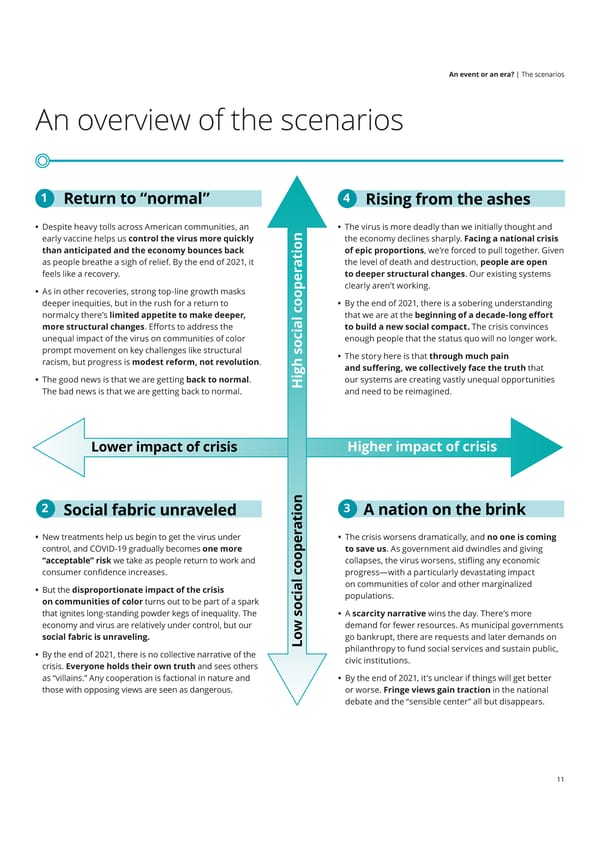An event or an era? | The scenarios An overview of the scenarios 1 Return to “normal” 4 Rising from the ashes • Despite heavy tolls across American communities, an n • The virus is more deadly than we initially thought and early vaccine helps us control the virus more quickly the economy declines sharply. Facing a national crisis than anticipated and the economy bounces back tio of epic proportions, we’re forced to pull together. Given as people breathe a sigh of relief. By the end of 2021, it a the level of death and destruction, people are open feels like a recovery. r to deeper structural changes. Our existing systems e clearly aren’t working. • As in other recoveries, strong top-line growth masks p deeper inequities, but in the rush for a return to o • By the end of 2021, there is a sobering understanding o c normalcy there’s limited appetite to make deeper, that we are at the beginning of a decade-long effort l more structural changes. Efforts to address the a to build a new social compact. The crisis convinces unequal impact of the virus on communities of color ci enough people that the status quo will no longer work. prompt movement on key challenges like structural o s racism, but progress is modest reform, not revolution. • The story here is that through much pain h and suffering, we collectively face the truth that • The good news is that we are getting back to normal. g our systems are creating vastly unequal opportunities The bad news is that we are getting back to normal. Hi and need to be reimagined. Lower impact of crisis Higher impact of crisis n 2 Social fabric unraveled o 3 A nation on the brink i t a • New treatments help us begin to get the virus under r • The crisis worsens dramatically, and no one is coming control, and COVID-19 gradually becomes one more e to save us. As government aid dwindles and giving p “acceptable” risk we take as people return to work and oo collapses, the virus worsens, stifling any economic consumer confidence increases. c progress—with a particularly devastating impact l on communities of color and other marginalized • But the disproportionate impact of the crisis a i populations. on communities of color turns out to be part of a spark c that ignites long-standing powder kegs of inequality. The so • A scarcity narrative wins the day. There’s more economy and virus are relatively under control, but our demand for fewer resources. As municipal governments social fabric is unraveling. w go bankrupt, there are requests and later demands on • By the end of 2021, there is no collective narrative of the Lo philanthropy to fund social services and sustain public, crisis. Everyone holds their own truth and sees others civic institutions. as “villains.” Any cooperation is factional in nature and • By the end of 2021, it’s unclear if things will get better those with opposing views are seen as dangerous. or worse. Fringe views gain traction in the national debate and the “sensible center” all but disappears. 11
 US Deloitte Monitor Institute Page 10 Page 12
US Deloitte Monitor Institute Page 10 Page 12